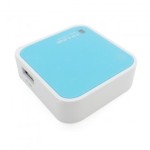My SD card became corrupted… again! When I tried to reformat it with the SD formatter tool (from the sdcard.org site) I always got the wrong size (even if the FORMAT SIZE ADJUSTMENT was ON). Googling for a solution did not help: I tried diskpart and other freeware tools, nothing helped.
At the end I found a solution by my-self: start the usual format with Windows (using the slow full format mode). While the format is in progress, physically remove the SD card from the drive: this will corrupt the data on the card. Now insert the card again: Windows will ask you to format the card since it cannot read it. Format it again: this time the card size will be correct!

 wireless shield was a bit too expensive. Then I found the TP-LINK TL-WR703N 3G router (
wireless shield was a bit too expensive. Then I found the TP-LINK TL-WR703N 3G router (